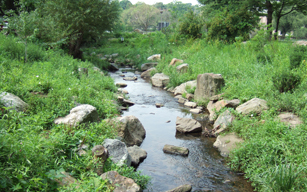7) Blind Brook at Rye High School, Rye
 Like Stephenson Brook, the County restored a section of Blind Brook on the grounds of Rye Middle/High School. The stream banks were severely eroding, exposing stormwater pipes, cutting away part of a soccer field and effecting water quality by increasing sediment loads. Rather than resorting to concrete and rock, the County regraded the stream banks to make them flatter, installed coconut fiber mats and bio-degradable biologs to stabilize the banks, and added shoreline vegetation and shrubs to control erosion. These efforts have also lead to enhanced habitats for wildlife. The newly stabilized banks have stood up to hurricanes and other severe storms.
Like Stephenson Brook, the County restored a section of Blind Brook on the grounds of Rye Middle/High School. The stream banks were severely eroding, exposing stormwater pipes, cutting away part of a soccer field and effecting water quality by increasing sediment loads. Rather than resorting to concrete and rock, the County regraded the stream banks to make them flatter, installed coconut fiber mats and bio-degradable biologs to stabilize the banks, and added shoreline vegetation and shrubs to control erosion. These efforts have also lead to enhanced habitats for wildlife. The newly stabilized banks have stood up to hurricanes and other severe storms.
To View The Site: The site is next to Rye Middle/High School on Parsons Street along Blind Brook in the City of Rye.
 This project, on the grounds of New Rochelle High School, was completed to stabilize the steep and eroding banks along Stephenson Brook.
This project, on the grounds of New Rochelle High School, was completed to stabilize the steep and eroding banks along Stephenson Brook.
 East Creek was severely degraded by bacteria and waste oil. It contained trash and debris, turning the creek into a small wasteland. Stream channel improvements, naturalistic stream bank stabilization, and stream buffer enhancements transformed the stream. During construction, truckloads of discarded junk and automobile parts from the stream channel and banks were removed
East Creek was severely degraded by bacteria and waste oil. It contained trash and debris, turning the creek into a small wasteland. Stream channel improvements, naturalistic stream bank stabilization, and stream buffer enhancements transformed the stream. During construction, truckloads of discarded junk and automobile parts from the stream channel and banks were removed and dozens of non-native and invasive shrubs and trees were eradicated. A tide gate was installed to curb the influx of salt water into the creek and the stream banks were re-planted with more beneficial native shrubs and trees.
and dozens of non-native and invasive shrubs and trees were eradicated. A tide gate was installed to curb the influx of salt water into the creek and the stream banks were re-planted with more beneficial native shrubs and trees. Eroding stream banks, an unsightly fence intended to keep geese off the lawn, and grass creeping to the edge of the brook used to greet visitors to Rich Manor Park. In 1999, the County enhanced habitat along the brook edge with the creation of a wet meadow and conservation buffer strip. The County also created a vernal pool. Vernal pools are among the most rare of habitats in
Eroding stream banks, an unsightly fence intended to keep geese off the lawn, and grass creeping to the edge of the brook used to greet visitors to Rich Manor Park. In 1999, the County enhanced habitat along the brook edge with the creation of a wet meadow and conservation buffer strip. The County also created a vernal pool. Vernal pools are among the most rare of habitats in Westchester County and are critical to the breeding success of many species of amphibians and invertebrates. The meadow and buffer vegetation filter pollutants before stormwater runoff enters the brook, keep geese off the lawn in a more natural way, and provide habitat to a variety of wildlife.
Westchester County and are critical to the breeding success of many species of amphibians and invertebrates. The meadow and buffer vegetation filter pollutants before stormwater runoff enters the brook, keep geese off the lawn in a more natural way, and provide habitat to a variety of wildlife. A two-acre site between Park and Bradford avenues was converted from a severely degraded marsh into a haven for wildlife and a natural water filter. First, dense common reeds (Phragmites australis) as well as junk that included an abandoned shed and car, steel drums, and automobile parts were removed. Then thousands of native plants representing more than two dozen species were installed, as were shrubs and trees that
A two-acre site between Park and Bradford avenues was converted from a severely degraded marsh into a haven for wildlife and a natural water filter. First, dense common reeds (Phragmites australis) as well as junk that included an abandoned shed and car, steel drums, and automobile parts were removed. Then thousands of native plants representing more than two dozen species were installed, as were shrubs and trees that included dogwood, ash, maple, oak and sycamore. Roosts for herons and swales for breeding turtles were installed, as was a subsurface structure in the stream channel to reduce stream bank erosion. The plants provide habitat for fish and wildlife and help filter out pollutants and excess nutrients before they enter adjacent Beaver Swamp Brook and downstream Long Island Sound.
included dogwood, ash, maple, oak and sycamore. Roosts for herons and swales for breeding turtles were installed, as was a subsurface structure in the stream channel to reduce stream bank erosion. The plants provide habitat for fish and wildlife and help filter out pollutants and excess nutrients before they enter adjacent Beaver Swamp Brook and downstream Long Island Sound.